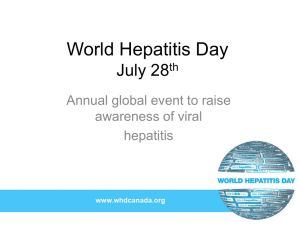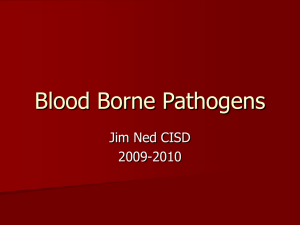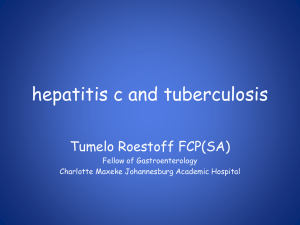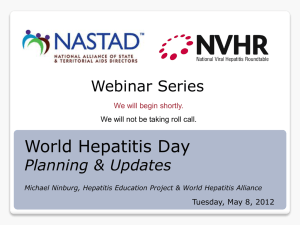View / the Hepatitis C presentation
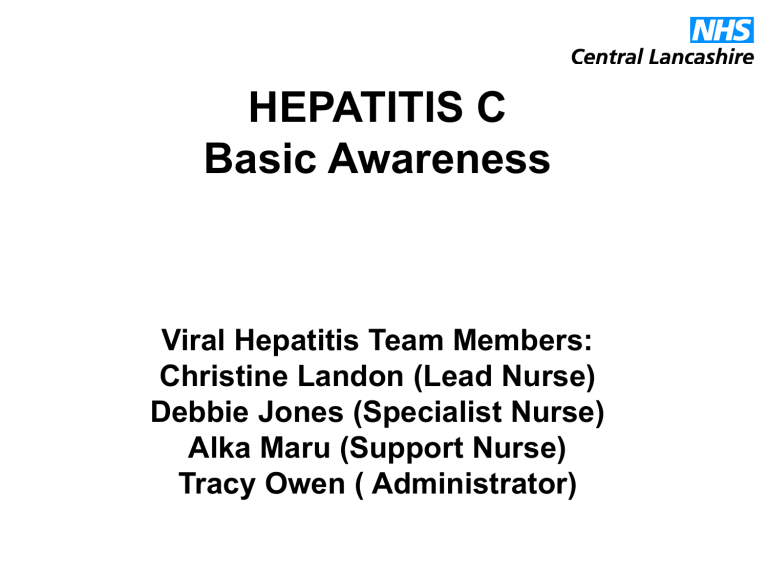
HEPATITIS C
Basic Awareness
Viral Hepatitis Team Members:
Christine Landon (Lead Nurse)
Debbie Jones (Specialist Nurse)
Alka Maru (Support Nurse)
Tracy Owen ( Administrator)
Hepatitis C: Global Burden of
Disease
3% of world population infected
5 million of these cases in western Europe
The world health organisation describe Hepatitis C as a
“ Viral Time Bomb”
(British Liver Trust 2009)
Hepatitis C: UK Burden of
Disease
250,000 people in UK are infected with hepatitis C
the Indian subcontinent are at increased risk of infection
prevalence of hepatitis C is more than 2 per cent in people born in
Pakistan.
Americas
13.1 million
(1.7%)
Screening: Identifying Estimated 170 Million
Persons With HCV
Infection Worldwide
Europe
8.9 million
(1.03%)
Africa
31.9 million
(5.3%)
Eastern
Mediterranean
21.3 million
(4.6%)
Western
Pacific
62.2 million
(3.9%)
Southeast Asia
32.3 million
(2.15%)
History Of Hepatitis C
Discovered in 1989
UK blood donations screened from September 1991
Some patients have been infected with medical/dental practices up to 1991 in the UK
Currently no Vaccination for Hepatitis C
More infectious than HIV!!!
WHAT IS HEPATITIS C?
Virus
Transmitted by blood
Causes inflammation and scarring of the liver
What is Hepatitis C?
Acute illness lasts approximately 6 months
25% of people infected clear the virus
75% go on to develop chronic disease
Chronic disease is defined as lasting longer than 6 months
Hepatitis C infection and the
Liver
Liver disease varies in each individual with Hepatitis C
Age at infection plays a part in accelerating liver disease
Increased alcohol consumption
Co- infection with other viruses e.g. HIV and Hepatitis A/B
(British Liver Trust 2009)
Hepatitis C and its effect on the liver
1 in 3 will go on to develop serious liver damage cirrhosis
(scarring to the liver) over a 20 year time period
Cirrhosis leads to permanent damage of the liver
Can lead to liver cancer
Early death
( British Liver Trust 2009)
Symptoms of Hepatitis C
Vague : (usually go unnoticed)
Flu like illness : chills, fever, night sweats, headaches
Pain in the Liver area
Poor concentration (Brain Fog)
Jaundice (uncommon in Hepatitis C )
Unexplained liver function raised ALT
• It is unknown why some people 25 % successfully clear hepatitis C
(British liver Trust 2009)
Transmission of Hepatitis C
‘Usually transmitted by direct contact with blood of an infected person’
(
DOH Get Tested get Treated 2009)
HOW HEPATITIS C PASSES
FROM PERSON TO PERSON
• Sharing personal items e.g. razors/ toothbrushes
• Tattooing/Body Piercing ,acupuncture, electrolysis (was the equipment Sterile?)
• Surgical/medical/Dental exposure abroad
• From mother to baby at birth 6%
• Sharing IV drug injecting equipment needles, syringes spoons, water, filters ,spoons.
• Vaginal ,anal, oral sex without a condom
(DOH Get Tested get Treated 2009)
• http://www.nhs.uk/hepatitisc/southasian/pa ges/home.aspx
HOW CAN WE REDUCE
THE RISK OF
TRANSMISION OF
HEPATITIS C?
WHO SHOULD WE OFFER TO
TEST?
History of injecting drugs (even once)
Born in a country with a high prevalence of Hepatitis
C
Is a child of a mother with hepatitis C
Abnormal LFT
Raised ALT
Medical/dental procedure abroad were infection control was poor
An accidental exposure to infected blood
(DOH Get Tested Get Treated 2009)
More reasons to offer to test?
Blood transfusion before 1991
Blood products before 1986
Unlicensed Tattoos or Piercing, acupuncture, electrolysis
A regular sexual partner with hepatitis C
( DOH Get Tested Get Treated Campaign 2009)
HOW DO WE TEST?
Offer a pre test discussion?
DOH Get Tested Get Treated have an simple online risk assessment
Advise blood tests will be needed to check for the virus
Patients can self refer to the Viral Hepatitis Team for information
WHY TEST?
Early diagnosis
Early referral for specialist assessment
Early treatment opportunity
Could have successful clearance of disease (up to
80%)
Reduce transmission
( DOH Get Tested Get Treated 2009)
Giving Results to the Patient
Negative antibody result :
• Offer ways of avoiding infection/ Harm reduction measures
Positive antibody result:
• Advise do not carry donor cards or give blood
Positive PCR result :
• Advise to stop alcohol
• Harm reduction for partner and family members
Negative PCR result:
• Advise a 2 nd test 4 to 6 weeks to confirm the negative status
• (DOH Get Tested Get Treated 2009)
Referral To Gastroenterology
Over 18
Full assessment by Gastroenterology
Nice recommendations are combination therapy
• Pegylated interferon
• Ribavarin
Length of treatment 24 to 48 weeks depending on geno type
11 geno types
6 common types are treated
Offer hepatitis A and B immunisation
• (DOH Get Tested get Treated 2009)
Pregnancy
HEPATITIS C
Vertical Transmission Of
Hepatitis C
Risk of infection by a mother with Hepatitis C to her child is Approximately 6 %
It is unknown if this transmission occurs
• In the womb
• At delivery
• After delivery
It is not at conception
Pregnancy
Pregnant women are offered testing for hepatitis C if a RISK is identified during their antenatal care.
If hepatitis C is diagnosed:
• The midwife will refer to The Viral Hepatitis Team
• Viral hepatitis team will arrange to see the patient
• Offer newborn hepatitis B vaccination and blood tests
Hepatitis C mothers Concerns
Breastfeeding :
Breast feeding is considered safe unless nipples are cracked or bleeding
Breast feeding is not recommended if the mother is
HIV positive
References:
British Liver trust (2000) ‘Understanding Hepatitis B, a liver disease’.
British Liver trust Leaflet
British Liver trust (2009) ‘A professional guide to Hepatitis B’. British Liver trust Booklet
Blackpool, Central Lancashire, Cumbria & North Lancashire PCT (2009)
Managerial content of patients group direction for Hepatitis B vaccine.PCT
Department of Health (DoH) (2007) Hepatitis B: How to protect your baby.
DoH Publications
Department of Health (DoH) (2009) Get Tested Get Treated. www.nhs.uk/hepatitisc
Green Book” Immunisation against Infectious Diseases (2006) www.dh.gov.uk/en/Policyand guidance/healthandsocialcaretopics/greenbook/DH_4097254
World Health Organization. Hepatitis C: Global Prevalence: Update. 2003.
